Carnivore cheesecake might sound like a contradiction, but this carnivore cheesecake recipe proves that indulgent desserts don’t have to break your diet. If you’re craving something creamy, comforting, and completely low-carb, you’re in the right place.
Made with just a few wholesome, animal-based ingredients, this cheesecake is rich, satisfying, and 100% carnivore-approved. It’s the perfect treat when you need something sweet without sacrificing your goals.
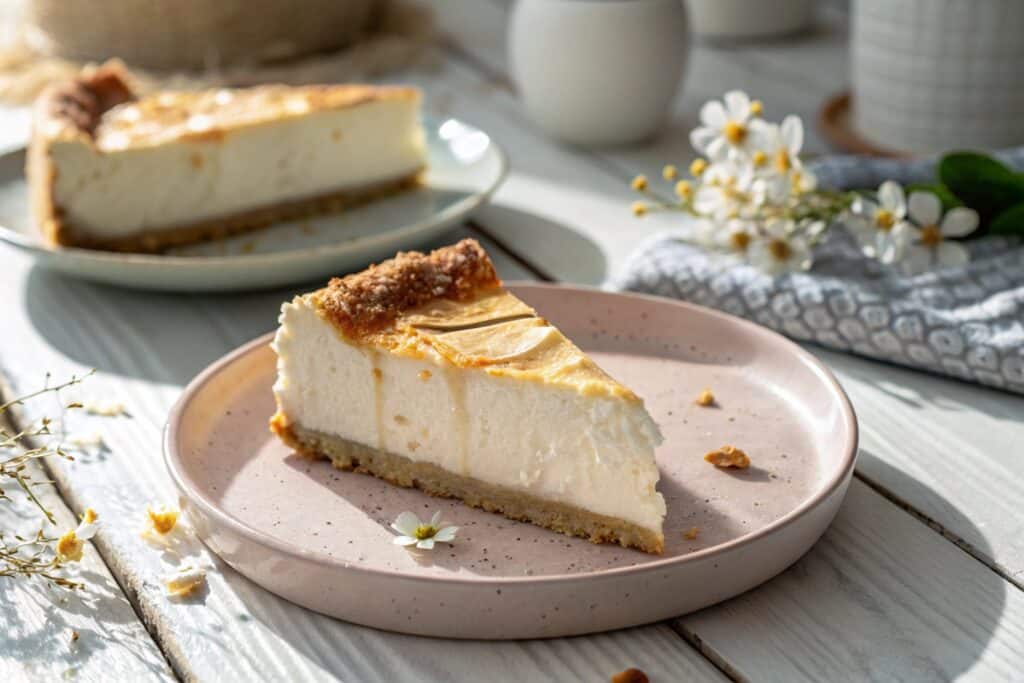
Table of Contents
Table of Contents
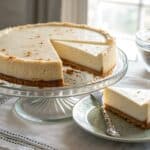
Carnivore Cheesecak Dessert
- Total Time: 4 hours 40 minutes
- Yield: 8 slices 1x
Description
This carnivore cheesecake is dense, creamy, and made with just 4 animal-based ingredients. It’s a zero-carb dessert you can enjoy anytime without breaking your diet.
Ingredients
16 oz full-fat cream cheese (softened)
3 large pasture-raised eggs
2 tbsp heavy cream (optional)
Pinch of sea salt
Instructions
1. Preheat oven to 325°F (163°C).
2. Let cream cheese sit at room temperature until soft.
3. In a large bowl, beat the cream cheese until smooth.
4. Add eggs one at a time, mixing well after each.
5. Add heavy cream and sea salt, then mix gently until fully combined.
6. Line a small baking pan with parchment paper.
7. Pour the mixture into the pan and tap to release air bubbles.
8. Bake for 25–30 minutes, until edges are set and center jiggles slightly.
9. Cool at room temperature for 1 hour.
10. Chill in the fridge for at least 4 hours or overnight before slicing.
Notes
Use lactose-free cream cheese or farmer’s cheese if sensitive to dairy.
Store in the fridge for up to 7 days or freeze slices individually.
Serve with whipped ghee or enjoy plain.
Avoid using sweeteners or non-carnivore toppings.
- Prep Time: 10 minutes
- Cook Time: 30 minutes
- Category: Dessert
- Method: Baking
- Cuisine: Carnivore
Nutrition
- Serving Size: 1 slice
- Calories: 310
- Sugar: 0g
- Sodium: 290mg
- Fat: 29g
- Saturated Fat: 17g
- Unsaturated Fat: 11g
- Trans Fat: 0g
- Carbohydrates: 0g
- Fiber: 0g
- Protein: 9g
- Cholesterol: 165mg
🧁 Carnivore Cheesecake Changed My Dessert Game Completely
My Wellness Story and the Recipe That Sparked It
If you’re like me, switching to a carnivore lifestyle felt like saying goodbye to dessert forever. No more soft bites of sweetness after dinner. No more comfort foods. Just meat, eggs, and fat—day in, day out.
But one quiet night in my kitchen, craving something soothing, I grabbed what I had on hand: cream cheese, eggs, a splash of heavy cream. I wasn’t expecting much—just something to break the monotony. But what came out of the oven surprised me.
It was dense. Creamy. Silky. Deeply nourishing.
It didn’t just taste good—it made me feel good. For the first time, dessert didn’t feel like cheating. It felt like healing.
Since that night, this carnivore cheesecake has become a weekly tradition in my home. It’s also the most shared and remade recipe in my carnivore dessert collection. Even friends who don’t follow this way of eating ask for seconds—and they’re always shocked it’s 100% animal-based.
Because it’s made from just a few clean ingredients—cream cheese, pasture-raised eggs, and a touch of salt—it fits effortlessly into a strict carnivore or keto protocol. It’s high in nourishing fat, free from sugars and carbs, and deeply satisfying.
If you’re already enjoying staples like chicken-based snacks or indulging in a cold scoop of carnivore ice cream, this cheesecake is the missing piece that completes the picture.
If you’ve been missing dessert, comfort, or just a little pleasure on carnivore… this might change everything for you, too.
Carnivore Cheesecake Ingredients & Smart Substitutions
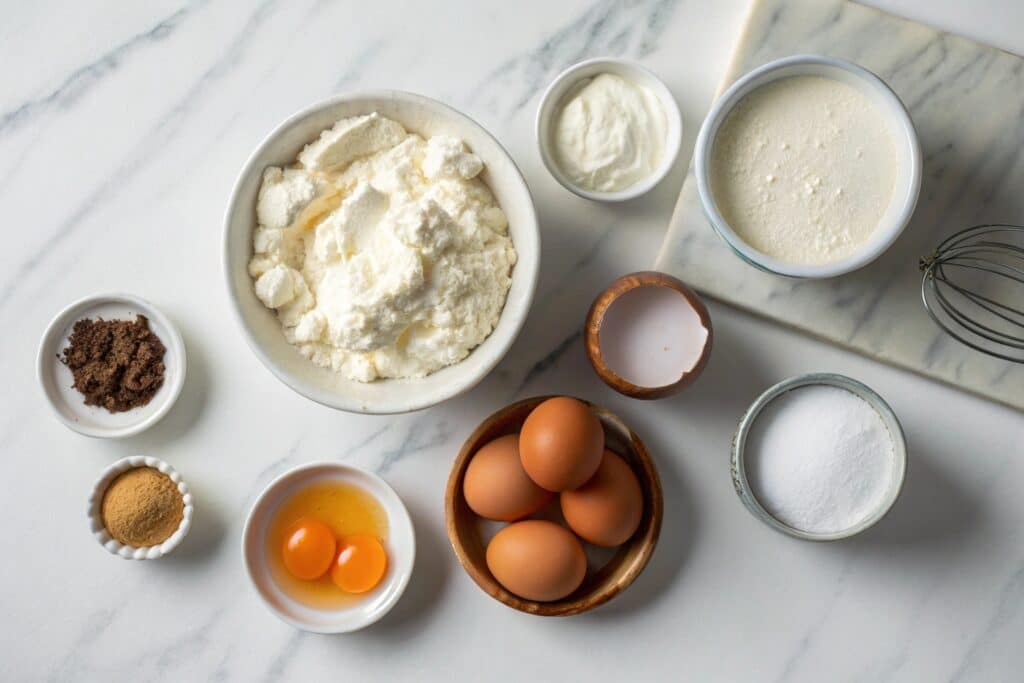
What Goes Into a Carnivore Cheesecake
This carnivore cheesecake uses just a few clean, animal-based ingredients. You won’t need anything fancy—only foods that nourish and support your low-carb goals.
Here’s what you need to get started:
- Full-fat cream cheese
- Pasture-raised eggs
- Heavy cream (optional, but adds smoothness)
- A pinch of sea salt
These simple ingredients create a cheesecake that’s creamy, dense, and surprisingly rich. The cream cheese is the base, while eggs hold it all together. A splash of cream gives it a velvety finish. Salt sharpens the flavor and makes each bite deeply satisfying.
This version of carnivore cheesecake isn’t just a treat. It’s loaded with protein and healthy fats, making it a solid option even for those following a strict carnivore plan.
Swaps for Dairy Sensitivities
If you’re sensitive to dairy, there’s no need to miss out. You can replace cream cheese with soft, cultured cheese like strained yogurt or farmer’s cheese. These give a lighter texture but still hold true to the carnivore lifestyle.
Don’t want to use cream? Leave it out. The eggs and cheese alone will create a firm and flavorful cheesecake. You’ll still enjoy that rich, indulgent feel with fewer ingredients.
For topping, skip whipped cream and use pure ghee or whipped tallow. Both are deeply satisfying and 100% carnivore-approved.
Batch cooking this cheesecake also works well. Just store slices in the fridge or freezer and reheat when needed. It’s a perfect make-ahead treat while following your meal prep routine.
Carnivore Cheesecake Made Easy: Steps for Perfect Texture
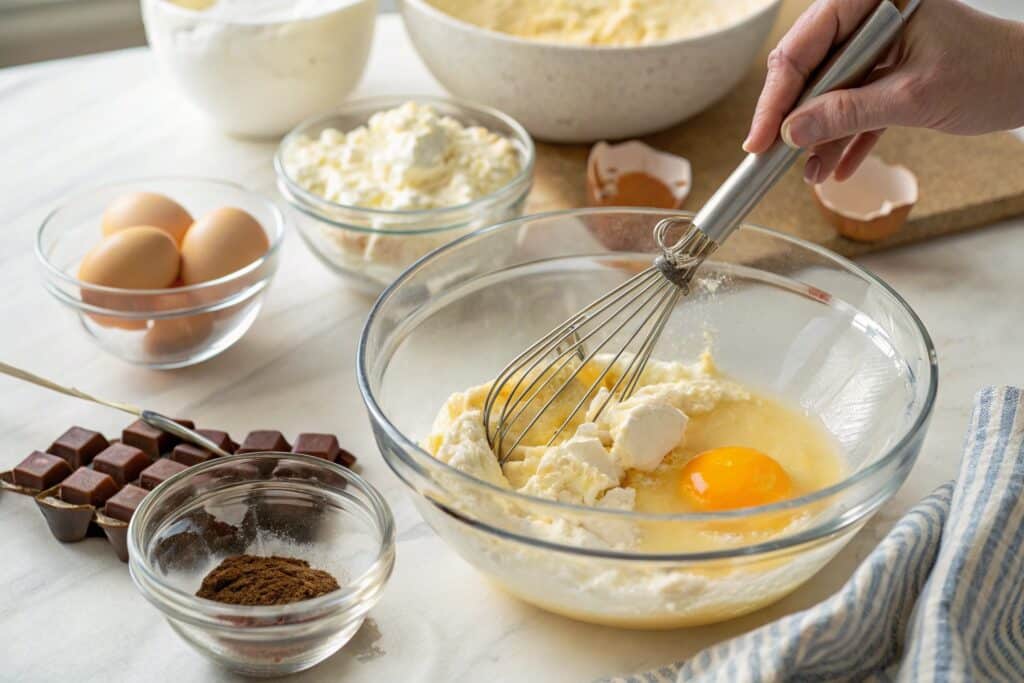
Step-by-Step Directions That Deliver Every Time
Making carnivore cheesecake is simpler than most expect. It only takes one bowl, basic tools, and a little patience. Here’s how to make it right every time.
Start by letting your cream cheese come to room temperature. This step matters—it makes mixing smooth and prevents lumps. In a large bowl, beat the cream cheese until it’s soft. Then add eggs one at a time. Mix gently. If using heavy cream and salt, fold them in last.
Line a small baking dish with parchment paper. Pour the batter in and tap the pan gently to release any air bubbles.
Bake your carnivore cheesecake at 325°F (163°C) for 25–30 minutes. Don’t overbake. The center should jiggle slightly. Once out of the oven, let it cool at room temperature for an hour. Then chill it in the fridge for at least four hours—or overnight for best results.
This slow-cool process prevents cracks and keeps the texture creamy and dense, just like a classic cheesecake.
Tools and Kitchen Tips to Make It Foolproof
You don’t need fancy tools for this recipe. A mixing bowl, hand whisk, and standard oven are enough. If you have a silicone mold or ramekins, those work great too, especially for individual servings.
To save time, you can double the batch and refrigerate slices for up to a week. This makes it easy to grab a snack after a hearty carnivore meal or enjoy it post-workout.
Want a fun twist? Try baking it into mini rounds for a carnivore dessert platter. They’re easy to portion and freeze well, too.
Follow this process, and your carnivore cheesecake will come out flawless—firm, creamy, and full of flavor.
Enjoying Carnivore Cheesecake Without Breaking Your Diet
How to Serve Carnivore Cheesecake Right
Once your carnivore cheesecake has cooled and set, it’s ready to enjoy. Slice it cold, straight from the fridge, for a dense and creamy bite. The texture is rich, so small portions go a long way.
For topping, forget fruit or syrups. Instead, try a spoonful of whipped ghee or a dollop of tallow cream. It’s decadent and keeps you fully carnivore.
You can also serve it alongside a warm cup of bone broth or an iced carnivore-friendly smoothie. This pairing makes for a satisfying, energy-packed treat—perfect after dinner or between meals.
Hosting guests? Cut into squares and serve as chilled bites. They’re great on a dessert board with other high-fat snacks like butter crisps or egg pudding cups.
However you enjoy it, this cheesecake fits seamlessly into your carnivore day—sweet comfort without the sugar.
Storage, Freezing, and Batch Prep Tips
This cheesecake isn’t just delicious—it’s also perfect for meal prep. Once fully chilled, it can stay fresh in the refrigerator for up to 7 days. Make sure to cover it tightly with parchment or wrap it in an airtight container to preserve its creamy texture and prevent it from absorbing fridge odors.
Want to make a bigger batch? Freeze individual slices by wrapping them in parchment paper and storing them in a sealed container. For the best consistency, thaw overnight in the fridge—this keeps the texture dense and smooth.
Avoid microwaving to defrost: it may over-soften or separate the fats, which ruins that perfect bite.
Pro Tip: For better portion control, slice it into small squares before freezing. That way, you can grab exactly what you need—no more, no less.
You can also get creative and bake mini versions in ramekins or silicone molds. They’re perfect for on-the-go snacks, portioning for kids, or building a carnivore dessert platter when hosting.
Visually, the cheesecake keeps its golden top and firm edges even after freezing—making each thawed slice feel like it’s freshly baked.
Whether you’re planning your week ahead or just want something indulgent to reach for after dinner, this carnivore cheesecake gives you comfort, nourishment, and control—without compromise.
Carnivore Cheesecake Variations & Flavor Twists
Add Variety Without Breaking the Rules
Once you’ve mastered the basic carnivore cheesecake, it’s time to get creative. You can easily change flavors and textures without adding carbs or sugar. The secret? Swap your base cheese or use different cooking methods.
Try ricotta instead of cream cheese for a lighter, fluffier version. If you want something denser, blend in some goat cheese—it brings a subtle tang that makes each bite more interesting.
For texture, beat your eggs separately and fold in whipped yolks last. This gives the cheesecake more lift without needing starch. You can also bake it in muffin tins or air-fryer molds for mini versions.
These small changes add variety to your dessert routine while keeping it strictly animal-based and satisfying.
Make It Fit Your Carnivore Routine
This cheesecake isn’t just for weekends—it can be part of your daily meal rhythm. Bake once, portion, and freeze slices for the week. After a filling lunch or a heavy carnivore dinner, one chilled square is enough to curb cravings.
Want something more filling? Serve with a side of egg custard or a carnivore smoothie for added fat and satisfaction.
For family meals or events, mini cheesecakes in ramekins make perfect carnivore-friendly desserts that still feel indulgent. You can even let them chill in silicone molds for easy removal.
With a little imagination, this recipe becomes more than dessert—it’s a flexible, fat-rich staple you can enjoy multiple ways, all within your lifestyle
Conclusion
Carnivore cheesecake is more than a dessert—it’s proof that you can enjoy something rich and satisfying without ever leaving your goals behind. With just a few simple ingredients, it delivers real comfort, real flavor, and real nourishment.
Whether you’re living strict carnivore or exploring your options, this recipe offers a way to treat yourself while staying on track. With every creamy bite, you’ll remember why you chose this lifestyle in the first place: to feel good, eat clean, and love your food.
There’s no need to settle when you can have the best. Make room in your routine for carnivore cheesecake—you deserve it.
Tried it? Share your version tag me on Facebook or Pinterest !
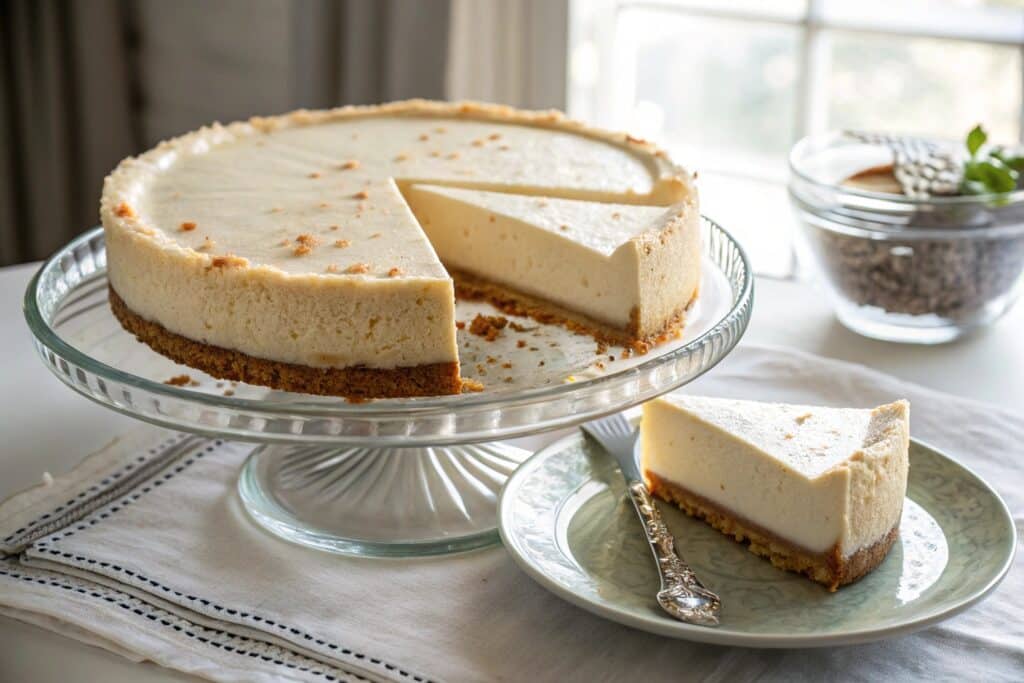
Frequently Asked Questions About Carnivore Cheesecake
Is cheesecake okay on a carnivore diet?
Yes, as long as it contains only animal-based ingredients. This carnivore cheesecake uses cream cheese, eggs, and heavy cream—no sweeteners, no nuts, and no carbs. It fits perfectly within a strict carnivore protocol.
Are there any desserts on the carnivore diet?
Definitely. While the diet is focused on meat and fat, there are ways to enjoy dessert-like textures using animal ingredients. Carnivore cheesecake, ice cream made from eggs and cream, and even custards can all be part of a carnivore dessert lineup.
Can you eat cream cheese on carnivore?
Yes, if you tolerate dairy, cream cheese is commonly used in carnivore recipes. Choose full-fat, plain varieties without additives. It’s high in fat, low in carbs, and perfect for recipes like this one.
What cheese is carnivore-friendly?
Hard cheeses like cheddar and parmesan, as well as soft ones like cream cheese or mascarpone, are generally acceptable. Stick to full-fat, minimally processed cheeses with no added starches or fillers.
